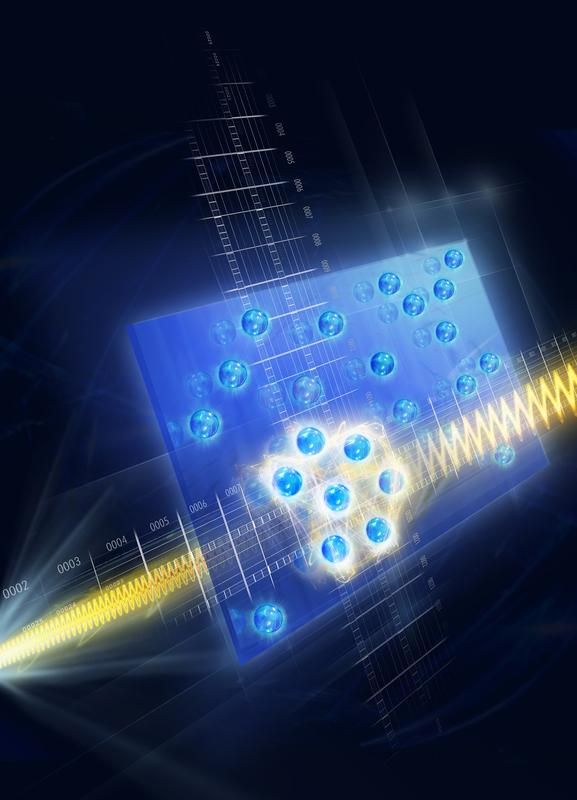Entanglement Becomes Easier to Measure

A new-found theoretical relation now allows extracting multiparticle entanglement with standard tools available in scattering experiments. IQOQI/Ritsch
In quantum theory, interactions among particles create fascinating correlations known as entanglement that cannot be explained by any means known to the classical world. Entanglement is a consequence of the probabilistic rules of quantum mechanics and seems to permit a peculiar instantaneous connection between particles over long distances that defies the laws of our macroscopic world – a phenomenon that Einstein referred to as “spooky action at a distance.”
Developing protocols to detect and quantify entanglement of many-particle quantum states is a key challenge for current experiments because entanglement becomes very difficult to study when many particles are involved.
“We are able to control smaller particle ensembles well, where we can measure entanglement in a relatively straight forward way,” says quantum physicist Philipp Hauke. However, “when we are dealing with a large system of entangled particles, this measurement is extremely complex or rather impossible because the resources required scale exponentially with the system size.”
Philipp Hauke and Peter Zoller from the Department of Theoretical Physics at the University of Innsbruck and the Institute for Quantum Optics and Quantum Information (IQOQI) at the Austrian Academy of Sciences in collaboration with Markus Heyl from the Technical University of Munich, and Luca Tagliacozzo from ICFO – The Institute of Photonic Sciences have found a new way to detect certain properties of many-particle entanglement independent of the size of the system and by using standard measurement tools.
Entanglement measurable via susceptibility
“When dealing with more complex systems, scientists had to carry out a large number of measurements to detect and quantify entanglement between many particles,” says Philipp Hauke. “Our protocol avoids this problem and can also be used for determining entanglement in macroscopic objects, which was nearly impossible until now.”
With this new method theoretical physicists are able to use tools already well established experimentally. In their study, published in Nature Physics, the team of researchers give explicit examples to demonstrate their framework: The entanglement of many-particle systems trapped in optical lattices can be determined by laser spectroscopy, and the well-established technique of neutron scattering may be used for measuring it in solid-state systems.
As the physicists have been able to show, the quantum Fisher information, which represents a reliable witness for genuinely multipartite entanglement, is in fact measurable. The researchers have highlighted that entanglement can be detected by measuring the dynamic response of a system caused by a perturbation, which can be determined by comparing individual measurements. “For example, when we move a sample through a time-dependent magnetic field, we can determine the system’s susceptibility towards the magnetic field through the measurement data and thereby detect and quantify internal entanglement,” explains Hauke.
Manifold applications
Quantum metrology, i.e. measurement techniques with increased precision exploiting quantum mechanics, is not the only important field of application of this protocol. It will also provide new perspectives for quantum simulations, where quantum entanglement is used as a resource for studying properties of quantum systems. In solid-state physics, the protocol may be used to investigate the role of entanglement in many-body systems, thereby providing a deeper understanding of quantum matter.
The research work was supported by the Austrian Science Fund and the European Research Council.
Publication: Measuring multipartite entanglement via dynamic susceptibilities. Philipp Hauke, Markus Heyl, Luca Tagliacozzo, Peter Zoller. Advanced Online Publication, Nature Physics, on 21 March 2016. http://dx.doi.org/10.1038/nphys3700
Contact:
Philipp Hauke
Department of Theoretical Physics
University of Innsbruck
phone: +43 512 507 4787
email: philipp.hauke@uibk.ac.at
Christian Flatz
Public Relations
University of Innsbruck
phone: +43 512 507 32022
email: christian.flatz@uibk.ac.at
http://www.uibk.ac.at/th-physik/qo – Quantum Optics Theory Group, University of Innsbruck
Media Contact
All latest news from the category: Physics and Astronomy
This area deals with the fundamental laws and building blocks of nature and how they interact, the properties and the behavior of matter, and research into space and time and their structures.
innovations-report provides in-depth reports and articles on subjects such as astrophysics, laser technologies, nuclear, quantum, particle and solid-state physics, nanotechnologies, planetary research and findings (Mars, Venus) and developments related to the Hubble Telescope.
Newest articles

NASA: Mystery of life’s handedness deepens
The mystery of why life uses molecules with specific orientations has deepened with a NASA-funded discovery that RNA — a key molecule thought to have potentially held the instructions for…

What are the effects of historic lithium mining on water quality?
Study reveals low levels of common contaminants but high levels of other elements in waters associated with an abandoned lithium mine. Lithium ore and mining waste from a historic lithium…

Quantum-inspired design boosts efficiency of heat-to-electricity conversion
Rice engineers take unconventional route to improving thermophotovoltaic systems. Researchers at Rice University have found a new way to improve a key element of thermophotovoltaic (TPV) systems, which convert heat…



